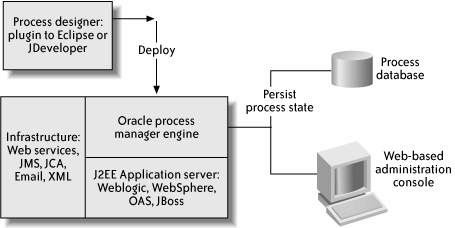10.1. Oracle BPEL Process Manager In 2004, Oracle joined the BPEL fray by acquiring Process Manager from Collaxa . The main pieces of Process Manager are a graphical design tool that plugs into the popular Open Source Java IDEs Eclipse (and also to Oracle's own JDeveloper ), as well as an execution engine that runs on most major J2EE application servers, including JBoss, BEA's Weblogic, IBM's Websphere, and Oracle's own Oracle Application Server (Oracle AS); a standalone lightweight version is also available. The solution also includes a web-based administration console (and a Java management API for custom management development) and a database to which process state is persisted (or dehydrated). Figure 10-3 illustrates the Process Manager stack. Process Manager is a compelling choice for developing the example:
It is free, easy to download, and easy to assemble You can download a free evaluation copy of BPEL Process Manager from Oracle's site to get a feel for the product. In this chapter's example, we will use the standalone server, eliminating the need to set up a full-fledged application server. The only missing pieces are a recent Java Development Kit and Eclipse, both free and easy to download. Figure 10-3. Oracle BPEL Process Manager architecture 
It is BPEL-compliant BPEL Process Manager appears to support most of BPEL 1.1.
It facilitates rapid development, testing, and administration The time required to create a new process (a one-step wizard creates a basic application), develop its first iteration (intuitive IDE with both graphical and code view), deploy it to the server (a single button-click from the IDE suffices, and the compile is very fast), and run a successful test of it (the administrative console generates an HTML form to inject an event into the process, and an audit trail to track progress) is admirably small, and subsequent iterations are equally fast. Process Manager is a complete solution, and it works well as a rapid application development environment.
It uses a Task Manager Service Oracle includes a reasonably functional human worklist subsystem, shown in Figure 10-4, whose design is similar to the ideal worklist component described in Chapter 2. In Oracle's usage, a BPEL process assigns a manual task by asynchronously calling the Oracle Task Manager service . A custom worklist application discovers the task by calling the Oracle Java Worklist API. The same API allows the worklist application to complete the task, and the service subsequently calls back the process with the result.[*] [*] Oracle, "BPEL Tutorial: Tutorial 6: Working with the Task Manager Service," http://www.oracle.com/technology/products/ias/bpel/pdf/orabpel-Tutorial6-TaskManagerServiceTutorial.pdf.
In the OAS 10g R2 release of BPEL Process Manager, Oracle introduced several enhancements to its human workflow capabilities: Out-of-the-box support for common human workflow patterns, such as simple approval, sequential and parallel approval, ad hoc processing, and automatic escalation Task assignment by role, user, or group; role-based task access control; integration with LDAP directory servers Task auditing , expiration, and delegation Figure 10-4. Oracle task manager 
A customizable worklist web application that provides users with the ability to see tasks and action them A notification service that delivers task information to users by email, phone, fax, and SMS. Users can perform actions on tasks by email
|

